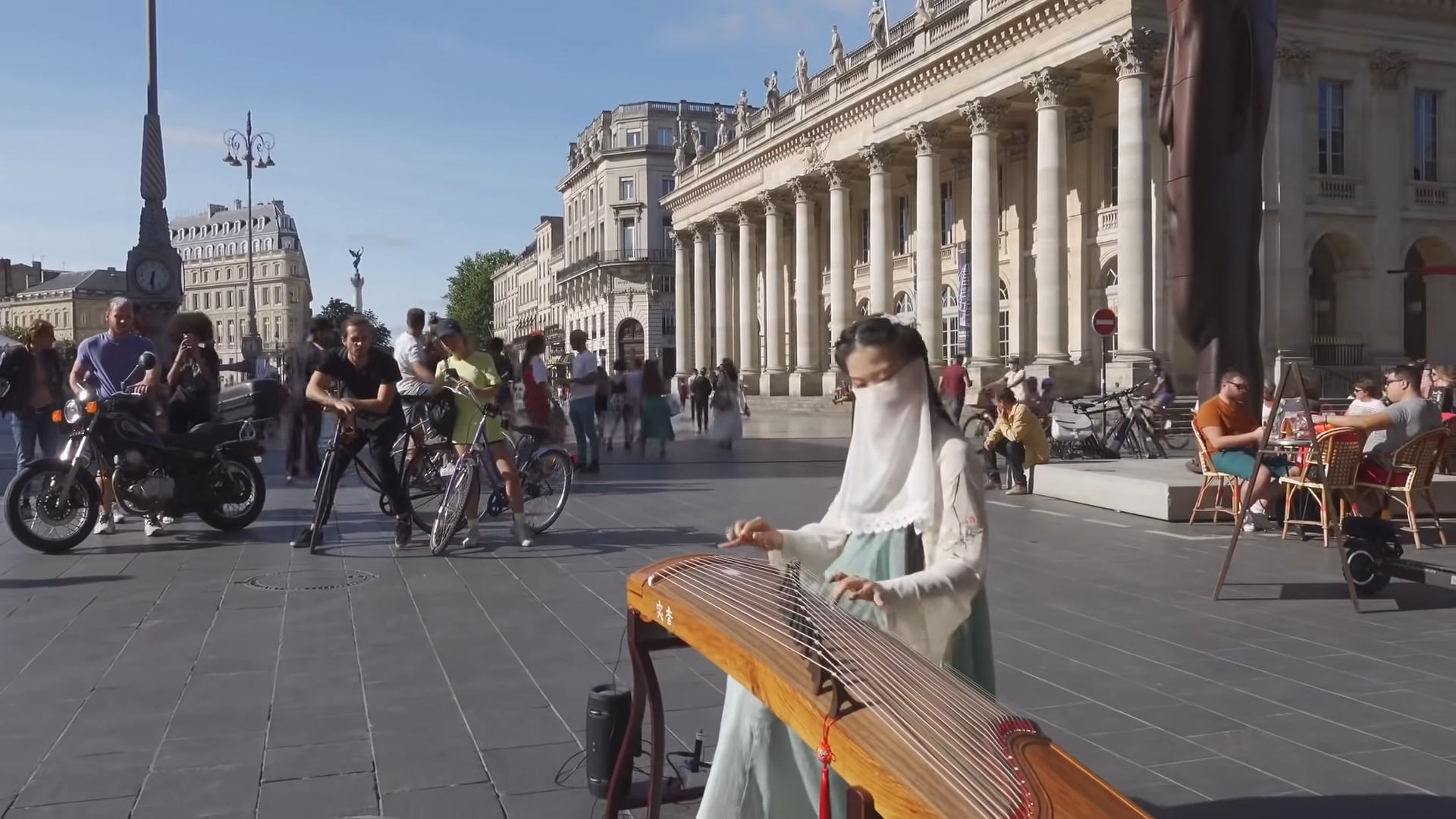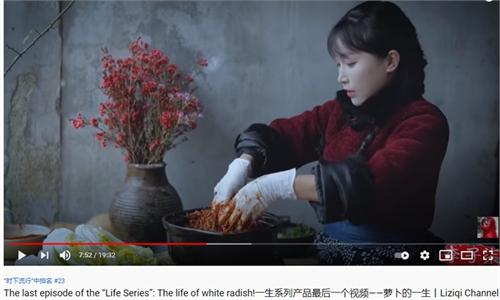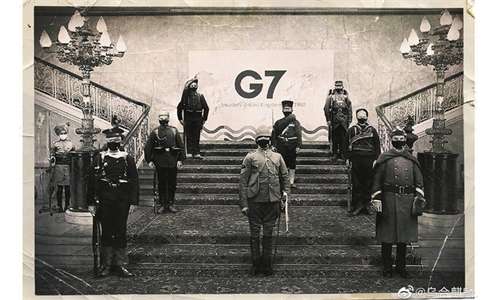IN-DEPTH / IN-DEPTH
Chinese vloggers, netizens actively respond to online hostility, present a real and diverse China
Human faces of diplomacy

Screenshot of Peng Jingxuan's video on YouTube, in which she performs the Chinese Song Yi Jian Mei on the guzheng, a traditional music instrument, on the streets in France.
Wang Dewen, a craftsman and YouTube vlogger under the pseudonym Grandpa Amu from East China's Shandong Province, uploaded his latest video earlier this month, which soon captivated thousands of global viewers.
In the video, Wang digs up old bamboo roots and crafts them into a beautiful bamboo fruit basket, a bamboo frog, and a tumbler. Putting fruits in the newly made basket, eating the fruits, and playing the bamboo frog together with his little grandson, the scenes in Wang's video promote a feeling of comfort.
"We want the world to see China's great techniques of traditional woodcrafts," Wang's son, Wang Baocheng, who helps shoot and upload Wang's videos, told the Global Times.
Without any nails, screws, or glue, and using only several pieces of wood, a saw, and a chisel, Wang can create various exquisite items from water wheels and folding stools to smaller handicrafts. Wang's extraordinary traditional Chinese woodworking skills have gained this 64-year-old popularity on YouTube, attracting more than 1.4 million followers.
Audiences said they love the workmanship and the idyllic life that Wang's videos show. "Chinese traditional no-nail building [skill] is awesome," a YouTube user commented under his latest video. "I wish my life could be as simple and peaceful as his," wrote another.
An increasing number of ordinary Chinese people have begun sharing their lives and thoughts on overseas social media platforms in recent years. They either upload self-shot videos and photos onto YouTube or Instagram, or communicate with foreign netizens on Twitter or Facebook, actively showing the world a real, vivid, and diverse China in various aspects from culture and arts to current affairs including on the topic of COVID-19.
Scholars in international relations and communication reached by the Global Times praised the attempts these people have inadvertently made in promoting the world's understanding of China.
"Their efforts have made people feel that public diplomacy, based on people-to-people connections, is a new [style] of diplomacy that is more vigorous and humanistic than the traditional one," Steven Dong, professor and dean of the School of Government and Public Affairs under the Communication University of China, told the Global Times.
Displaying cultural charm
A professional videographer, Wang Baocheng used to make entertaining cooking videos in the past but they were not well received by netizens, until 2017, when he uploaded a video of his father making a wooden chair, which unexpectedly gained more than 1 million views in just a day.
"I believe this is because currently, an increasing number of people are eager to learn about traditional Chinese culture and yearn for the natural and simple country life in their increasingly busy lives," Wang Baocheng said.
In 2018, Wang Baocheng helped his father register his YouTube account Grandpa Amu to share the various wooden handicrafts his father made. "For the first half of his life, my father made his living as a carpenter, but now he has taken pleasure in honing and promoting his skills," Wang Baocheng said.
"We feel proud and pleased when seeing YouTube viewers from different countries expressing their love for traditional Chinese culture and for Grandpa Amu in different languages," he told the Global Times. "They have inspired us to create more and better videos, and handicraft works."
At present, Grandpa Amu has shared 276 original videos on YouTube, with the most popular hitting more than 54 million views.
Foreign audiences seem quite welcoming to videos exhibiting Chinese culture, including handicrafts, music, clothes, and food. One of the most well-known Chinese vloggers is Li Ziqi, a 31-year-old woman who attracts a global audience and media with videos of her engaged in various tasks at her farm in her fairyland-like village in Southwest China's Sichuan Province.
Some without English subtitles, Li's and Grandpa Amu's videos don't specifically target overseas audiences. While other content creators like Shiyin, a 27-year-old enthusiast of the traditional Chinese costume, Hanfu, who grew up in Canada, makes bilingual videos at times to introduce English-speaking audiences to the beauty of Hanfu, as well as its related embroidery skills and fabrics knowledge.
Shiyin was called a "fashion influencer shaping China's Hanfu style revival" by Vogue US in an article published in March. In a six-minute video she uploaded on YouTube in November 2020, which has had more than 423,300 views, she sits in front of the camera in delicate Ming Dynasty (1368-1644) style Hanfu, talking about Hanfu's history, features, and its differences from Korean Hanbok.
It's a pity that many Westerners, unfamiliar with Chinese culture, tend to think of Korean or Japanese culture first when seeing a culture with "oriental elements," said Shiyin. But actually, the cultures of East Asian countries were largely influenced by traditional Chinese culture before they became what they are today, she said.
To promote foreign audiences' understanding of Chinese culture, including costume culture is, therefore, an original intention to create such bilingual videos, Shiyin said. Her YouTube account has had some 240,000 followers.
"Having long been living in Western communities, I speak fluent English, understand Western culture, and understand Western mindset," Shiyin told the Global Times, saying these are her advantages in promoting Chinese culture overseas. "Plus my love for Hanfu and Chinese culture, I'd surely like to make my contributions [in cultural exports]," she added.
Thousands of miles away, Peng Jingxuan, a Chinese student studying in Bordeaux, France, regularly shares online video clips of her playing the traditional Chinese instrumental, guzheng, on the streets of French cities.

Screenshot of Shiyi's video on YouTube, in which she is dressed in Tang Dynasty (618-907) style Hanfu.
Within about one year, Peng's YouTube channel has attracted more than 276,000 followers, with many of them - who might have had no idea what a guzheng is - complimenting the songs she performs with this 2,500-year-old musical instrument as "amazing," "emotional," and "graceful" in different languages.
One of Peng's most popular videos with over 4.84 million views so far, was a clip of her performing the Chinese song Yi Jian Mei - dubbed as "Xue Hua Piao Piao Bei Feng Xiao Xiao" overseas - on a street in France last summer. Peng said she was very happy with the numerous comments under this video.
"Some said they felt 'a beautiful love story' in this song I performed with the guzheng," Peng told the Global Times, saying now she often received messages from all over the world asking for the name of a particular song she performed, or the ways of buying and learning to play the guzheng. "I realized that I can share some good things and emotions with them even though there's a language barrier," Peng said.
The "export" of China's traditional culture is more likely to be accepted by foreign audiences, as the spread of some of the country's "modern, contemporary things" have been prevented and slandered by the West, Dong said. "Under the current [political] siege by the West, it's not surprising that Chinese culture - which is glamorous enough in itself and transcends the political limits of the moment - has gained popularity overseas," he added.
Correcting misconception

Photo:VCG
Apart from culture vloggers, more ordinary Chinese netizens, particularly the young ones, have also stepped onto the international public opinion stage, observers have found. On social media platforms like Twitter and Facebook, they voluntarily clarify the rumors about China and make efforts in sharing the real China with overseas users.
Zhang Yuanhao, a postgraduate student studying in the US, said he has never stayed away from any major event happening in China, although he has given himself the screen name "The Outsider." Zhang actively explains China's policies and current state affairs to foreign netizens on Twitter and Facebook and rebuts unfounded claims made by hostile Western media outlets.
Zhang recalled that since the COVID-19 outbreak, he has witnessed countless waves of abuse against China on social media networks.
During the previous social unrest in Hong Kong caused by rioters in 2019, Zhang and his friends would usually include pictures of mobs attacking the police and civilians in text responses to questions and smears from Western netizens.
"We told them with facts that violent protests are not a pretty sight, but rather a source of social turmoil," Zhang said.
Li Ying, a 22-year-old student at a Sichuan-based university, recalled her experiences of refuting COVID-19-related stigmatizations on Twitter. When Li saw foreign users call the COVID-19 the "Chinese virus" or "Wuhan virus" under the official accounts of Chinese embassies and Foreign Ministry spokespersons, she would reply with a World Health Organization (WHO) statement, which said it was "extremely unlikely" that the virus spread from a lab leak in Wuhan.
"But no matter what you show them, some people won't change their minds anyway," Li told the Global Times, saying she has also encountered some Twitter users attacking Chinese-developed COVID-19 vaccines for no reason. "Blinded by ignorance and prejudice, they just decline to receive any factual information [about China]," she sighed.
Many Chinese users on international social media platforms told the Global Times that they feel the outside world, especially the West, still has lots of misconceptions and stereotypes about China. "Some Twitter users thought China is still a very backward country: No vehicles on the road and people walk barefoot as they can't afford shoes," Li exampled.
In terms of culture and art, Shiyin said that many Westerners' perception of China is still backward. "The Chinese elements in their artworks were things commonly seen in Hong Kong and Taiwan regions in the 1980s, like red lanterns, dragon-lion dances, and neon signs," Shiyin exampled. "This stereotype is far from an accurate portrayal of present-day Chinese culture, which is inclusive and aesthetically beautiful," she said.
Clearing up misunderstandings is not something that can be done overnight, Dong noted. Fortunately, Li and her peers said they feel that through their efforts, in some small details, foreign audiences' stereotypes about China are diminishing, and their views toward China are becoming more objective and positive.
In March, Li posted photos of the tourist attractions that she'd just been to in Wenchuan, a county in Sichuan where a devastating earthquake took place in 2008, on Facebook. The photos attracted several foreigners who praised the beautiful scenery.
"I told them that after the earthquake, the reconstruction in Wenchuan is very good," Li told the Global Times. Some Facebook users replied to Li, saying they were looking forward to going to China and visiting Wenchuan in person someday.
Peng said she is pleased with even more people around her getting to know and becoming interested in guzheng. "At least in Bordeaux, when I play the guzheng on the streets, I sometimes hear nearby people talking, 'hey, this is a guzheng, a Chinese instrument," Peng said.
Peng added that she is planning to perform in more cities across France, and then the whole of Europe, to let more Westerners know about the charm of the guzheng and Chinese music.
Shiyin has tried to make videos that involve more fields of traditional Chinese culture, from Hanfu to China's various facets of intangible cultural heritage. "As a major soft power, China's profound culture has a lot for people, both at home and abroad, to comprehensively know about," she said. "There is so much more for us to do."




